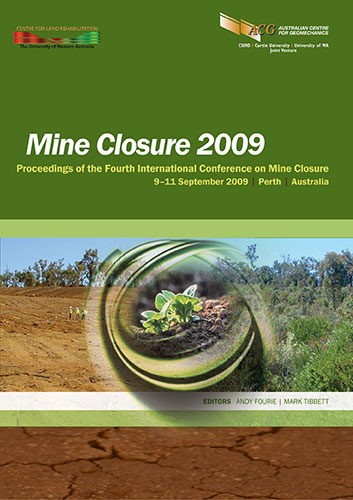Water covers for tailings and waste rock — designing for perpetuity

|
Authors: Brett, DM |
DOI https://doi.org/10.36487/ACG_repo/908_37
Cite As:
Brett, DM 2009, 'Water covers for tailings and waste rock — designing for perpetuity', in AB Fourie & M Tibbett (eds), Mine Closure 2009: Proceedings of the Fourth International Conference on Mine Closure, Australian Centre for Geomechanics, Perth, pp. 485-492, https://doi.org/10.36487/ACG_repo/908_37
Abstract:
Water covers are recognised as a preferred method of controlling oxidation of sulphides in tailings and waste rock, in climates where the availability of water is adequate to maintain continuous saturation. However, there is a resistance to this method for long-term, low maintenance closure of these storage facilities due to the perceived risks associated with water storage dams. Dams are closely regulated by government in most jurisdictions and require management systems appropriate to the hazard rating of the structure. This is determined in Australia using guidelines issued by the Australian National Committee on Large Dams (ANCOLD) and others, relating to the consequences of failure. Most mine storages would fit into the ANCOLD high hazard rating due to the environmental impact of their failure. The hazard rating imposes recommendations for design parameters, construction details and ongoing operational management. However, these recommendations have generally been developed for operating water storage dams and require a level of management that becomes unrealistic for a closed mine storage. The solution is to develop design and construction practices for mine waste storages that reduce the risk of failure to acceptably low levels that allow reduction in the scope of long-term management. This paper describes how risk assessment methods can be used to develop the design of mine waste storages that can support water covers for long-term performance.
References:
Australian National Committee on Large Dams (ANCOLD) (1998) Guidelines for Design of Dams for Earthquake,
90 p.
Australian National Committee on Large Dams (ANCOLD) (2003) Guidelines on Dam Safety Management, 52 p.
Benckert, A. and Eurenius, J. (2001) Tailings Dam Constructions, Seminar on Safe Tailings Dam Constructions,
Gallivare, Sweden, Swedish Mining Association, Natur Vards Verket, European Commission, pp. 30–36.
Bjelkevik, A. (2005) Water Cover Closure for Tailings Dams – State of the Art Report, Luleå University of
Technology, Division of Geotechnology, Sweden, 103 p.
Brett, D.M. (2008) When Is A Dam Not A Dam? Annual Conference on Dams, ANCOLD, Gold Coast, Queensland.
Brett, D. and French, D. (2008) Mushy Closure of Pond-B, Barrick Henty Gold Mine, 6th Australian Workshop on
Acid and Metalliferous Drainage (AMD), Burnie, Tasmania.
Brett, D.M., Koehnken, K. and Cordery, G. (2009) TSF Water Covers in Tasmania, Australia - Practice, Performance
and Closure Issues, Securing the Future and 8th ICARD, Skellefteå, Sweden.
Department of Industry Tourism and Resources (DITR) (2007) Leading Practice Sustainable Development Program for
the Mining Industry – Tailings Management, Australian Government.
Eurenius, J. (1990) Long-Term Studies and Design of Tailings Dams, International Symposium on Safety and
Rehabilitation of Tailings Dams, Sydney, ICOLD.
Fell, R., Bowles, D., Anderson, L. and Bell, G. (2000) The Status of Methods for Estimating the Probability of Failure
of Dams for Use in Quantitative Risk Assessment, International Commission on Large Dams, 20th Congress,
Beijing, China.
Foster, M., Fell, R. and Spannagle, M (1998) Risk Assessment – Estimating The Probability of Failure of Embankment
Dams by Piping, ANCOLD Conference on Dams, Sydney, Australia, Proceedings.
Makdisi, F. and Seed, H. (1978) A Simplified Procedure for Estimating Dam and Embankment Earthquake-induced
Deformations, Journal of the Geotechnical Division, ASCE, Vol. 105, No. GT7, pp. 849–867.
Pisaniello, J.D. and McKay, J.M. (2006) The Need for Private Dam Safety Assurance: a follow-up ‘model’ policy from
Tasmania’, The Australian Journal of Emergency Management, Vol. 21, No. 2, pp. 45–51.
Standards Australia/Standards New Zealand (SA/SNZ) (2006) Handbook – Environmental Risk Management—
Principles and Process, third edition, HB 203:2006, Standards Australia, Sydney, and Standards New Zealand,
Wellington, New Zealand, 98 p.
© Copyright 2025, Australian Centre for Geomechanics (ACG), The University of Western Australia. All rights reserved.
View copyright/legal information
Please direct any queries or error reports to repository-acg@uwa.edu.au
View copyright/legal information
Please direct any queries or error reports to repository-acg@uwa.edu.au